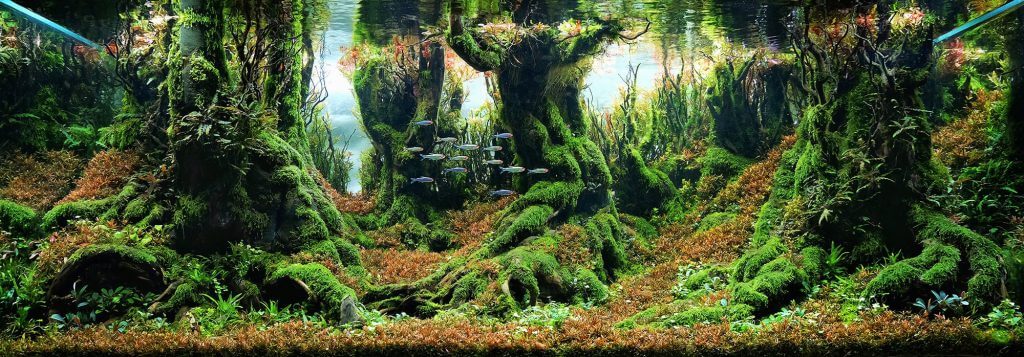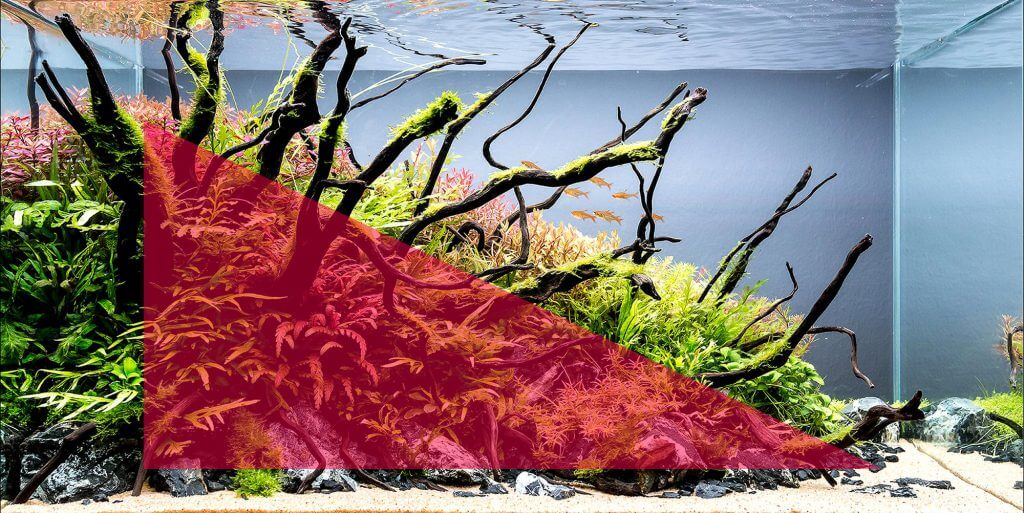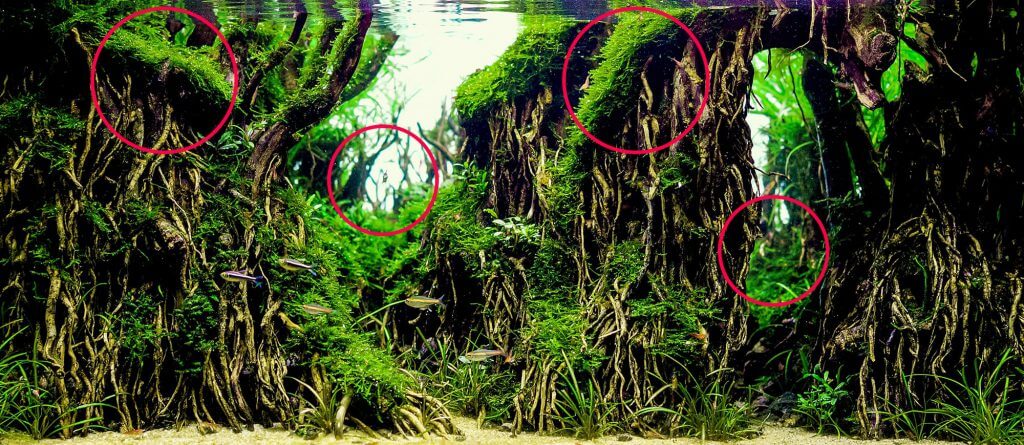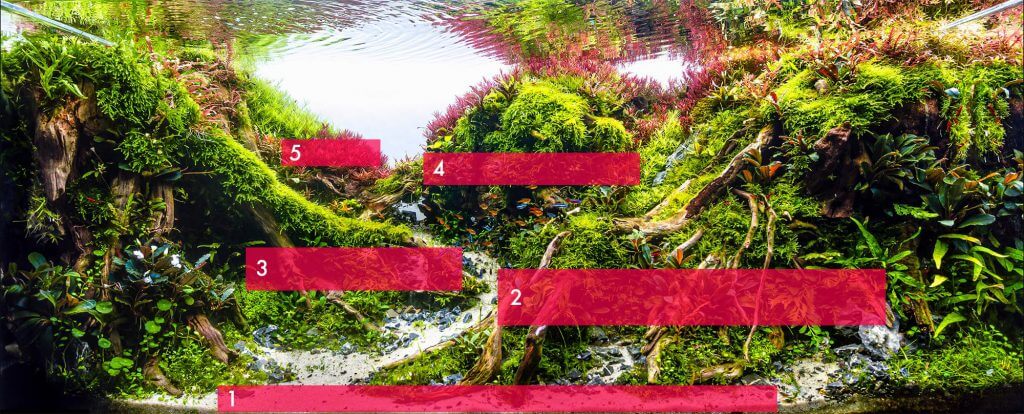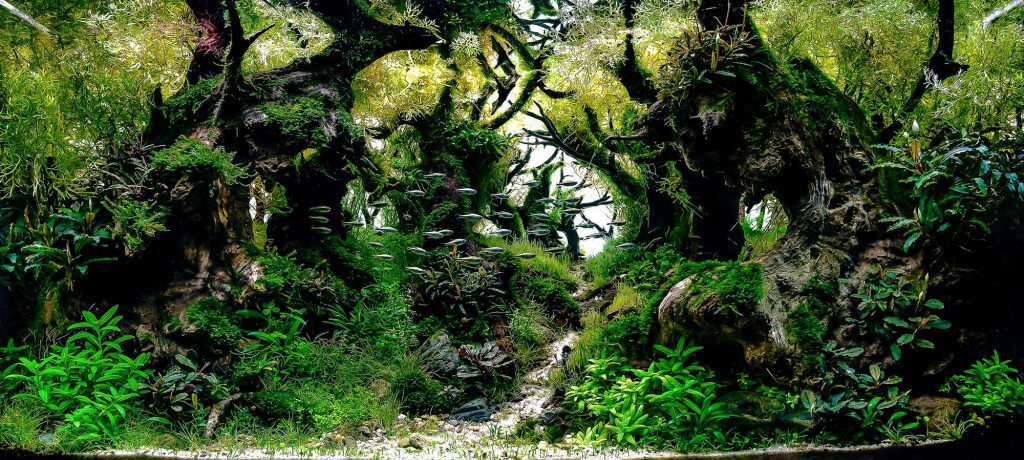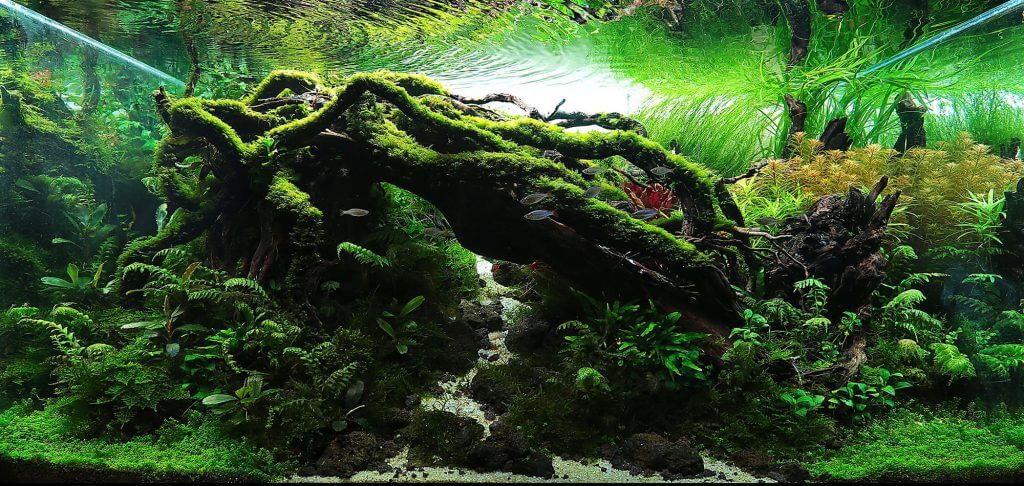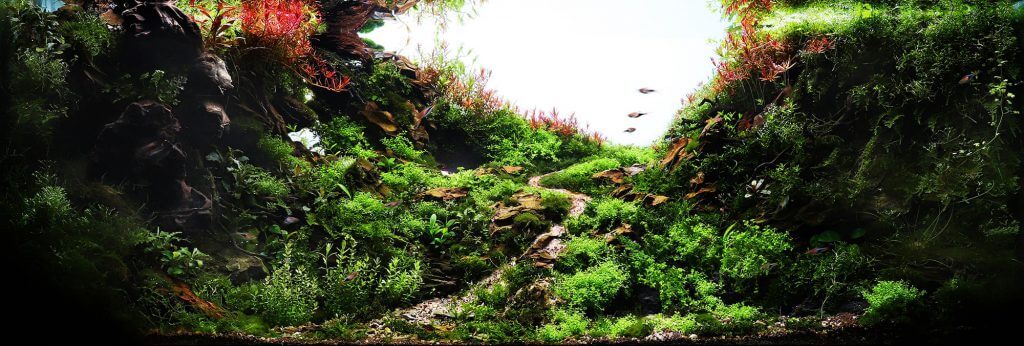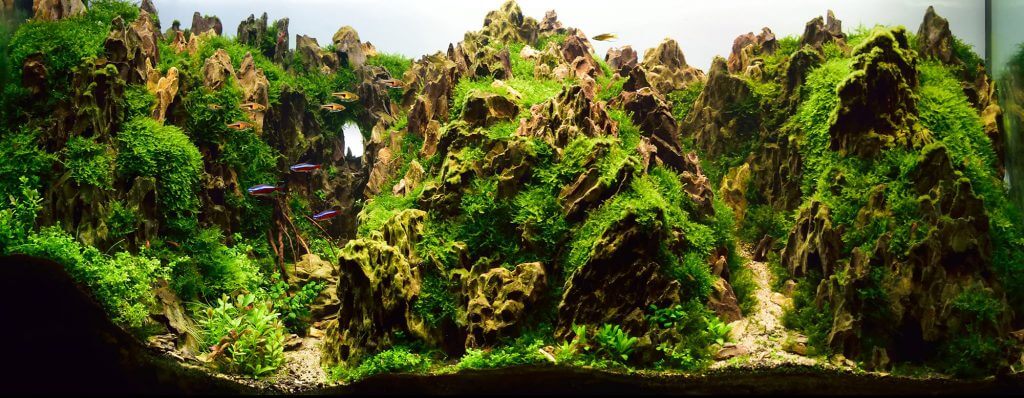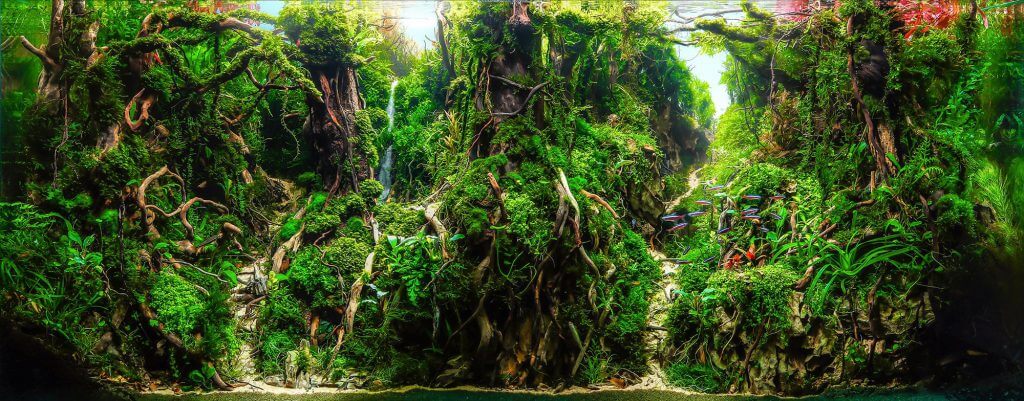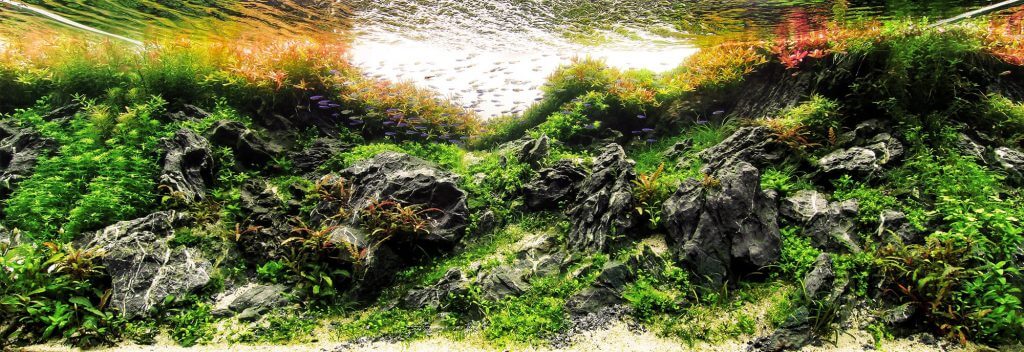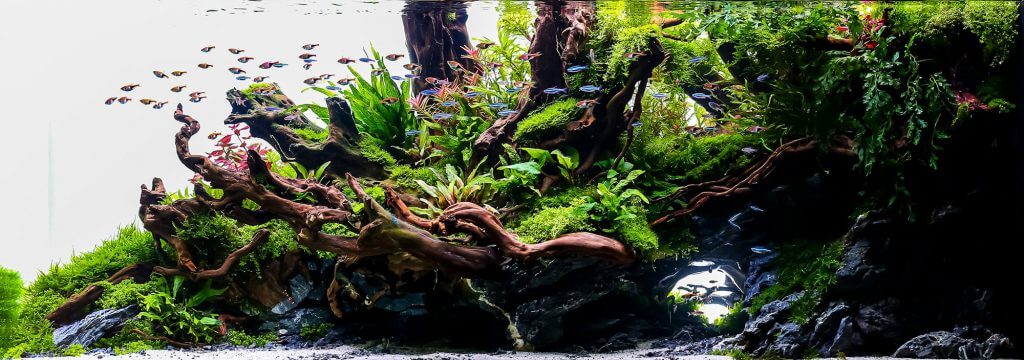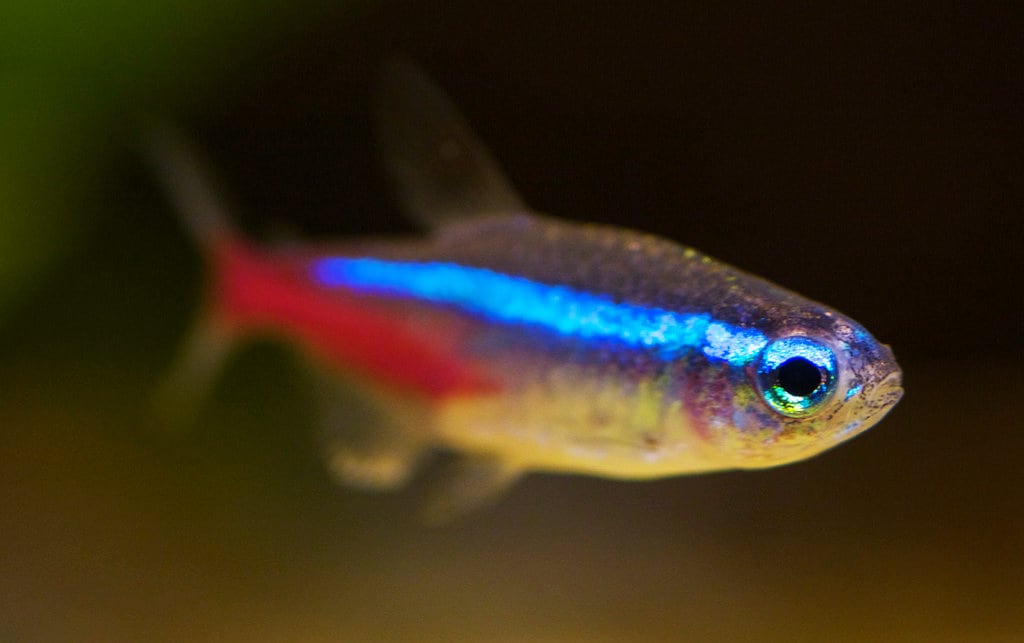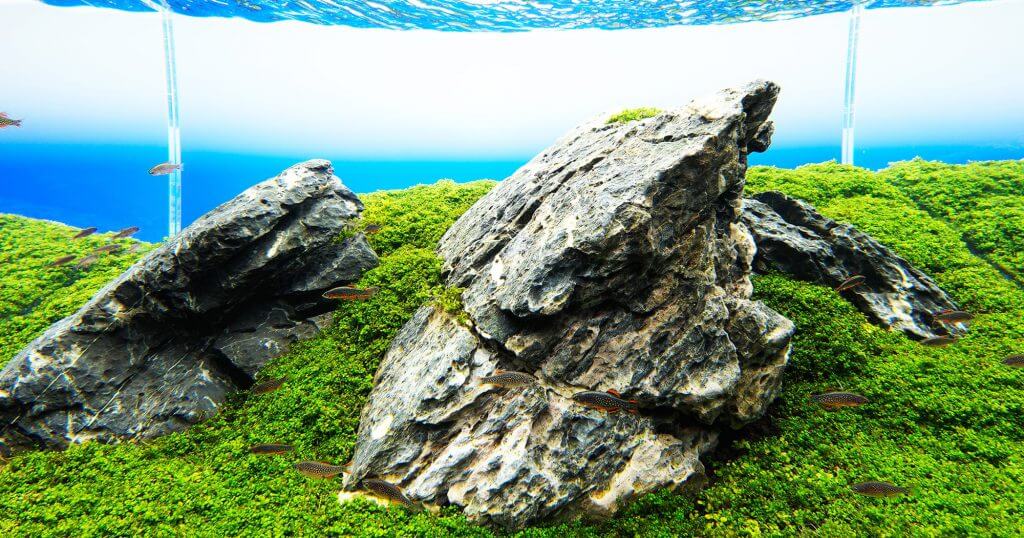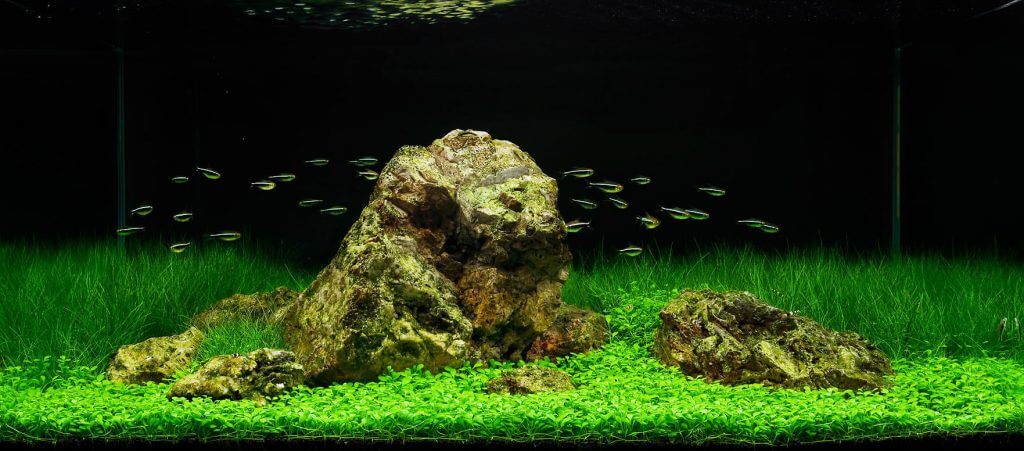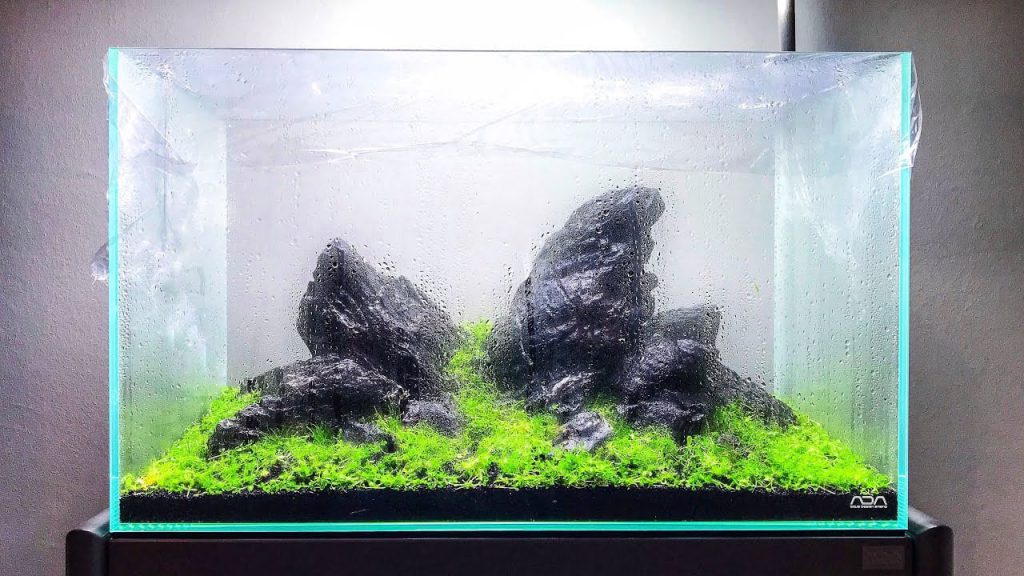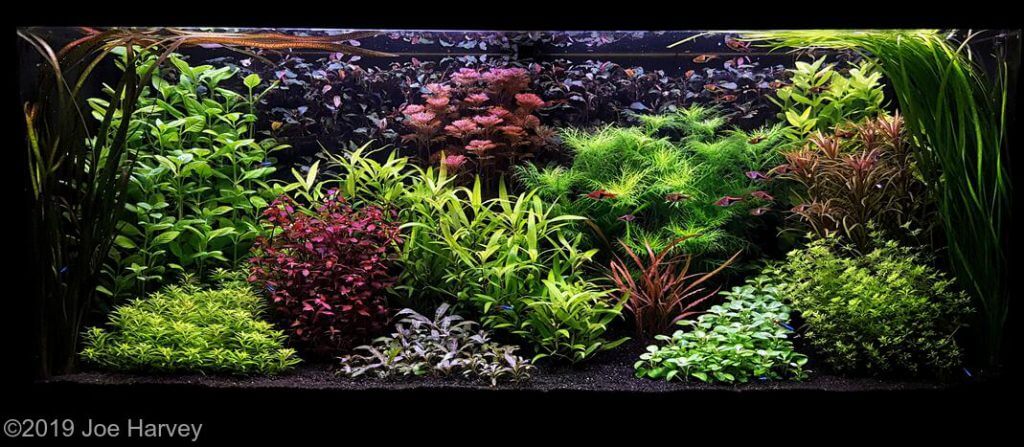
The art of aquascaping opens up a world full of creative and artistic arrangements of plants and hardscape (rocks and driftwood) within a tank. There are endless possibilities regarding how one can design a planted aquarium, the only limit being each person’s creative potential.
With time, different types of layouts gave birth to a variety of styles and approaches. Three major styles emerged in modern aquascaping: Nature Aquarium style, Iwagumi and the Dutch Aquarium. Each style having unique features and characteristics, with one of them – the Nature Aquarium, employing a variety of themes and sub-styles.
- Table of contents
- 1. The Nature Aquarium
- 2. Iwagumi – A Japanese-inspired Aquascaping style
- 3. The Dutch Aquarium
The Nature Aquarium
The Nature Aquarium is most definitely the style dominating the world of aquascaping these days. The basic Nature style design concepts were introduced by Japanese aquarist Takashi Amano back in the 90s and have become widely popular over the years, influencing the future of young aquascapers.
So What is a Nature Aquarium?
This aquascaping style is characterized by attention to the alignment and grouping of hardscape. Rocks and driftwood are mixed with aquatic plants in order to create an underwater replica of a particular terrestrial landscape. Mountains, rainforests, lush green hillsides, valleys and even beaches are re-imagined inside the Nature Aquarium.
Elements of Japanese gardening are generally used when building a Nature aquarium, such as the implementation of the Golden ratio.
Even though the general appearance of the Nature style aquascape makes it seem unplanned, quite random and without design, the truth is accomplishing this type of layout requires a lot of complex work.
Most aquascapers plan their Nature Aquarium before even getting their hands wet. Pencil and paper work great when trying to visualise the design of your next aquascape.
Stones and driftwood are organized carefully alongside asymmetrical arrangements of groups of aquatic plants in order to create natural ambience and flow.
The Simple Nature Aquarium
It’s not very hard to accomplish an aesthetically pleasing Nature style composition for your aquarium. All you need to do is invest in some proper planting substrate and some quality hardscape materials like branched out pieces of wood and some unique looking rocks as well as some carefully selected plants.
When we consider the simple Nature Aquarium layout, there are three visual styles you can try out:
1. The Concave Shape
The positioning and height of the plants decreases to some central low point so that the final display offers the impression of open space in the middle.
2. The Convex Shaped Style
This layout is often referred at as an island because plants are trimmed lower on either side and higher in the middle, which is very nice aesthetically and can be obtained with rocks to make a mountain looking scape.
3. The Triangle Shaped Aquascape
This type of layout creates very balanced visuals; the height of the plants slopes gradually from high on one side of the aquarium to low on the other side.
Advanced Design Techniques in the Nature Aquarium
Seasoned aquascapers use a set of rules and techniques when building their Nature Aquariums. These rules give the final design the WOW effect, that feeling that makes you wonder whether or not the scene you’re looking at is real.
Focal points play an important role in the Nature Aquarium. Perspective gives depth to the scene you’re replicating and layering creates the illusion of 3D. A theme gives a clear identity to your planted tank.
Josh Sim, aquascaping champion from Malaysia, along with many other world renowned aquascapers, use all these principles and design rules when creating their scapes. Let’s break them down and see how you can apply them in your future tanks.
Depth
A Nature Aquarium that employs depth gives the impression that the scape is larger (deeper) than it appears. A good depth easily impresses the viewer and also makes the Aquascape score good points in a contest.
You create depth by first defining an End point (or vantage point). This is the main focal point of your scape. It’s where the viewer’s eye first gaze upon.
Then, you have to place your substrate so that it’s higher in the back and lower in the front. Use small hardscape pieces in the back and big in the front. Essentially, creating contrast in sizes generates a good depth.
Depth also makes use of perspective. If you’re into drawing you know how important perspective is when creating a scene. Learn more about perspective.
Focal Points
Focal points catch the viewer’s attention and guide him across the underwater scene. You create these visual spots within your Aquascape by using various materials and techniques. Lots of things can represent a focal point: a big piece of driftwood, an unusual-looking rock, shadows, plant arrangements etc.
Strive to create between 1 and 3 focal points in your Nature Aquarium. Of course, there are exceptions to this rule, as some scapes lack clear focal points.
Layering – Creating the Illusion of 3D in Your Nature Aquarium
A very powerful technique, layering is a great skill to master if you want to stand out as an aquascaper. Creating layers in your scene improves your overall perspective and depth and gives a sense of richness and complexity.
It turns the underwater landscape into a 3D design. An Aquascape that is built with layers is in no way static or boring. It immerses the viewer into a dynamic and complex scenery.
But how do you build layers in your aquascape?
Simply by not placing your hardscape materials on the same ground level. Use variety in sizes and thickness. Driftwood have to be thin and thick, rocks big and small, and so on. Color contrasts also help when creating layers.
If you’re a beginning aquascaper start with 2 layers. Then add another one. And so on. Once you get more experienced with designing Nature Aquariums you should have no problem creating more than 3 layers in your tank. Most award-winning Aquascapes have 4 or 5 layers. That should be your goal.
Shadow – Creating Suspense in Your Scene
Ignored by many aquascapers, the element of shadow in your Nature Aquarium gives the viewer a sense of tension and generates emotional uneasiness. It creates feelings of a mysterious and melancholic nature. It makes your overall design look powerful and dynamic.
Here’s some examples where shadow is applied efficiently:
Most award-winning Nature Aquariums have an area between 30% and 60% covered in shadows.
How do you create shadow in your Nature Aquarium?
Shadow is defined by a dark area where light is being blocked by an object. In aquariums, because the light source comes from a single direction – the top, it’s very easy to create shadows.
Block the light by using a large piece of driftwood or rock. Sometimes you create shadow by placing a bigger object in a 2nd or 3rd layer of your aquascape. Don’t put this object straight. By placing it at a 45 degrees angle it will lean across the lower layers so it’ll easily create shadows.
Space – Filling the Tank with Your Scene
Space management within your tank is another great skill that advanced aquascapers get good at. They make use of the whole space in the aquarium: front to back and top to bottom. Every inch is taken into consideration and is equally important in the final design.
Think of a blank canvas waiting to be painted. No artist ever left half of it blank. The painting fills the whole space of the canvas, left to right and top to bottom.
Most beginning aquascapers only use half of a tank’s available space and this gives an empty look. Or the feeling that something is missing.
Empty areas are purposefully created, like in the case of the End point. Or any other spots that have the role of being a focal point.
Reflection plays an important part in space management. Left, right and top reflection adds visual interest to your final design.
There is though one big problem with space management within your aquascape. You can easily overcrowd the design and give out a feeling of congestion. By efficiently applying perspective and layering in your tank, you can make sure that this doesn’t happen.
Another good way to avoid overcrowding is to look at your tank from the side and draw an imaginary line from top-right to bottom left. This line divides the space between what has to be filled and what shall remain empty. Brazilian-style Nature Aquariums usually use this strategy.
Integration and Unity – Making Your Scene Look Natural
This refers to the overall look of your aquascape. Every element have to be contained into your scene. Driftwood, rocks and aquatic plants have to be seamlessly integrated so as to make the final design look like a natural scene. You don’t want to give the viewer the feeling that a certain element doesn’t belong there.
Mixing different species of plants together gives a feeling of natural development. Using rocks and driftwood of various sizes helps in mimicking the natural underwater environment.
Creating Contrast in the Nature Aquarium
Contrast is the difference in size, color, shape and appearance between your Aquascaping elements (hardscape, plants, substrates). Contrast can also be applied in terms of how you place and arrange these elements: far or near and high or low. Fish can also create contrast of movement in your tank.
Contrast is an important feature in your Aquascape design and can heavily influence other discussed techniques like layering and perspective.
Some common contrast types found in modern Nature Aquariums include:
- Big and small: placing big driftwood in front and small in the back, bushy plants vs. small carpeting ones
- Far and near: usually found in tanks with astounding perspective
- Thick and thin: rainforest themes efficiently showcase this type of contrast by using driftwood of various thicknesses
Nature Aquarium Themes
A theme is a clear representation of a natural landscape that is reproduced inside your planted tank. It gives the aquarium a certain identity and immediately lets the viewer know what the artist is trying to portray.
A Nature Aquarium theme can depict various scenes such as: mountain ranges, valleys, tropical rainforests, cliffs and canyons, hillsides, islands and many other natural sights.
Mountain Range Theme
This type of Nature Aquarium is dominated by rocks and small stones. The hardscape is arranged in a way so to replicate a mountain range found in nature. Sometimes small pieces of driftwood are added to complement the stonework.
Rainforest Theme
Driftwood is the main ingredient when creating a rainforest scene in your tank. Straight or wavy pieces of wood are carefully intertwined with plants, generating amazing details. Aquatic moss is heavily used here along with other small to medium plants like Anubias, Bucephalandra and Cryptocoryne.
Big rocks are used but only as a supporting ground for the layout. Small stones and pebbles are a good choice if you want to replicate a path that goes through the forest.
This type of Nature Aquarium theme usually fills the whole area of the tank with the only open space visible being the end point. By far the most skilled aquascapers that engage with this theme originate from Southeast Asia (Indonesia, Thailand, Malaysia).
Hillsides and Valleys Theme
This Nature Aquarium theme uses a combination of multiple rocks in order to recreate a valley landscape inside the tank. The layout is usually very high on the left and right sides, converging into a path near the middle of the tank.
The valley theme contains a wide diversity of aquatic plants including: Rotala, HC Cuba, Staurogyne, Bucephalandra, Hygrophila, Grossostigma, Echinodorus, Alternanthera and many other.
Brazilian aquascapers are well known to be masters at creating this theme.
Island Theme
The island theme is comprised of a somewhat equal distribution of rocks and driftwood. The hardscape is mixed together with plants in such a way that it creates a rounded or triangular layout.
Some space around this layout is left empty and filled with sand. This makes the viewer think of a tropical sandy beach.
What About Fish?
The selection of fish for the Nature Aquarium style aquascape is as important as the selection of hardscape and aquatic plants. Choose fish which complement your tank’s theme.
Take into consideration aspects regarding their behavior and way of living. Think of their size, shape and colors. If the fish are too large, they can disrupt your layout, pulling out the plants and hardscape. If the fish like to eat aquatic plants, that is definitely not desirable.
Look for small fish that like to swim in groups (schooling or shoaling species). Tetras, Rasboras and some Danios are without a doubt the most popular fish found in Nature Aquariums today.
Other species that work great include: Barbs, Killifish, Gouramis, Angelfish, Discus, Guppys, Siamese fighting fish and Rainbows.
Maintenance Difficulties of the Nature Aquarium Style
The majority of pains of the Nature Aquarium creation are connected to the plant growing process and their maintenance. It’s a long way to accomplishing a balanced, aesthetically pleasing Nature Aquarium tank.
Plants grow fast and densely so they need constant trimming in order to make the aquascape look beautiful and more natural with the passage of time. Special attention must be given to the choice of planting substrate (aquasoil). Proper substrate should contain a sufficient amount of nutrients, which enable the growth of healthy plants.
Another common issue often encountered with the Nature Aquarium is algae control. Algae often become a problem soon after the layout is set up and the water quality is unstable. So make sure you take measures as soon as you notice there might be a complication of this sort.
Iwagumi – A Japanese-inspired Aquascaping Style
The Iwagumi layout is one of the most challenging aquascaping styles out there. While it looks simple to do at first glance, using only 1 or 2 types of slow-growing plants might generate algae problems right from the start.
Developed around 1985 by famous aquarist Takashi Amano, this type of aquascape represents not just a minimalist layout, but also reflects the Japanese culture, spirituality and love for beauty and simplicity.
Amano created his first Iwagumi Aquascape in a 60 cm aquarium, using Senmigawa stones. The whole layout was planted only with Echinodorus tenellus. Later a group of Cardinal Tetras was introduced into the tank. This practice was highly usual at that time.
He went on and created his second Iwagumi in a larger tank measuring W120 × D45 × H45 cm, using the same plants and fish as in his first one.
Nowadays some of his Iwagumi tanks are still present in the ADA Gallery in Japan, welcoming thousands of visitors each year.
Features of the Iwagumi Style Aquascape
The Iwagumi term itself comes from the Japanese ‘rock formation’ and it therefore refers to a layout where stones play the leading role. Rocks provide the ‘bony’ structure of the aquascape. The traditional geography is a design made of three main stones, out of which one large headstone and two small others.
The most difficult task when it comes to the Iwagumi aquascaping style is to obtain that harmony and unity through simplicity. The Iwagumi is not about just collecting a number of stones but about placing them in a fluent, natural and spacious way. So that in the end they are related both to each other and the rest of the scape.
Basic Design Principles and Techniques
Not all Iwagumi aquascapes are of the Sanzon Iwagumi type, meaning a ‘three-pillared rock formation’. In fact, any number of rocks can be used, as long as it is an odd number (3, 5, 7 and so on) so as to avoid that sense of symmetry no one is striving for in aquascaping.
Among the most popular stones used for this type of aquascape are Seiryu, Manten and Ohko Dragon stones, but there’s no actual limitation regarding types. The aim is to build a group of rocks that are similar in color and texture, yet different in shapes and contour.
Regardless of their number, each stone in the Iwagumi layout has a name and a specific role:
Oyaishi – This is the primary stone. The largest and most beautiful of all stones, Oyaishi is always the main focal point of the Iwagumi layout. It is placed in accordance with the rule of thirds and it occupies 2/3 of its height, which is the perfect ratio for the human eye, according to The Golden Ratio theory. Oyaishi is also slightly tilted in the direction the water flows, in order to render a natural look, more similar to the river stones.
Fukuishi – The secondary stone, Fukuishi should resemble Oyaishi in color and texture and it is usually placed on its right or left, being the second largest rock in the Iwagumi aquarium. The main purpose of this stone is to balance out the primary stone and to create tension in the aquascape.
Soeishi – The third stone in the setup, usually placed next to the Oyaishi, along with the Fukuishi, accentuating the strength of the first one.
Suteishi – The fourth largest stone in the Iwagumi aquarium, Suteishi is also called ‘the sacrificial stone’, because it is not meant to stand out and it often gets covered by plants. Nevertheless, the role of the Suteishi is to compliment the entire rock formation by assisting all other stones in creating a sense of togetherness. In a Sanzon Iwagumi aquascape, the Suteishi is omitted.
Here is an example of Iwagumi layout consisting of all types of stones mentioned above:
Recommended Plants for the Iwagumi Layout
When it comes to planting an Iwagumi style aquascape, there’s a limited number of plants you can use (1-3). This is because, of course, the focus should remain on the stones, which should not be overcome by plants, and aquarium open space, which should prevail.
The most popular are small carpet plants like:
- Hemianthus callitrichoides Cuba (Dwarf baby tears)
- Eleocharis acicularis & parvula (Dwarf hairgrass)
- Glossostigma elatinoides
- Micranthemum umbrosum Monte Carlo
- Utricularia graminifolia
Other suggested plants for the Iwagumi aquascape include: Pogostemon helferi, Riccia fluitans (submersed and tied to rocks), and larger background plants like Vallisneria nana, Eleocharis vivipara, Staurogyne repens and Rotala sp.
Fish Used in the Iwagumi Aquarium
The Iwagumi tank is characterized by harmony and unity through simplicity so never forget that because it is important to maintain this feeling when you add fish to your tank. The purpose of fish should be to enhance the aquascape’s sense of tranquility through their fluid movement.
Aim for small schooling fish like the ones belonging to the Tetra or Rasbora groups. Specifically, the following species are great for Iwagumi layouts:
- Black neon tetra (Hyphessobrycon herbertaxelrodi)
- Cardinal tetra (Paracheirodon axelrodi)
- Rummy nose tetra (Hemigrammus rhodostomus)
- Glowlight tetra (Hemigrammus erythrozonus)
- Firehead tetra (Hemigrammus bleheri)
- Harlequin rasbora (Trigonostigma heteromorpha)
All these species are used because of their calm and gentle behavior. Make sure to always get them in groups of at least 10-12 individuals.
Complications and Pains of the Iwagumi Aquascape
Out of all aquascaping styles, the Iwagumi aquascape looks the easiest to accomplish because of the simplicity of its appearance, but the truth is it is the most difficult to obtain and even harder to maintain.
Limitation in the plant selection makes the growing process even more difficult for aquascapers. Plants used when creating the Iwagumi aquarium are heavy root feeders, making the choice of substrate delicate and the choice of water filtration as meticulous.
Not only does the Iwagumi ask for an extensive amount of experience in what the choice of plants and hardscape is regarded, but the aquascape itself becomes prone to algae formation.
Algae can appear even in the early stages of your aquarium’s development so pay very much attention and take measures if you notice signs of it. One solution to this problem is to limit the light period to around 6 hours a day.
Another great solution for avoiding initial algae growth is to apply the Dry Start Method when developing you Iwagumi aquascape.
Creating an Iwagumi Aquascape with the Dry Start Method
The Dry Start Method (DSM) help the plants to become established and growing lushly before you actually fill the aquarium with water. The only requirements are a nutrient-rich substrate (aquasoil) and a good aquarium light fixture.
DSM have been around for a while in the aquarium hobby and it was created specifically for helping people start Iwagumi tanks without encountering algae issues. It was developed by aquarist Tom Barr around the year 2007.
Here’s how it goes:
- After planting, the whole layout is sprayed with a misting bottle and then the tank is covered with a thin plastic wrap in order to maintain high humidity. The water level should only come up just below the lowest point of the substrate. Leave a thin area uncovered by plastic wrap to make sure there is some air flow in the tank.
- This way the plants will grow in their emerse form (out of water) for a period of 4 to 8 weeks.
- The light is turned on and kept for 8 -10 hours a day.
- The substrate is sprayed with water on a daily basis to maintain moisture and a high level of humidity.
- During this time the plants will feed off the nutrients contained in the rich substrate (aquasoil), developing new roots and expanding their growth area.
- Finally, after the dry start period passes, the tank can be flooded and the water cycling process can begin. It’s important not to stock the aquarium with fish at this stage.
- Trim the plants in order to promote new and faster growth and do a big water change (70-80%) after a day or two.
How to start an Iwagumi using the Dry Start Method:
The Dutch Aquarium: A style from the 1930s
The Dutch Aquarium Aquascape is the oldest style regarding planted tanks, becoming popular during the 1930’s in the Netherlands, with the implementation of the NBAT – the Dutch Society for Aquarists.
Special Features of the Dutch Aquarium
The Dutch Aquarium style does not imply the use of driftwood, rocks and other hardscape materials. The main focus is placed upon the growth and arrangement of aquatic plants.
Traditionally, Dutch planted aquariums are compared to underwater gardens. However, differentiating from the Nature style, Dutch aquascapes are not meant to resemble a specific scene from nature.
The intricate placement and grouping of plants help create in-depth perspective within the aquarium by complimenting each other in shape and color.
The most important requirement for aquascapers who want to approach the Dutch Aquarium style is to have extensive knowledge regarding aquatic plants. Since they represent the main materials used in Dutch aquascaping, it is very important to know how to plant, group and combine them so that the final arrangement would become aesthetically pleasing to the eye.
Most magnificent Dutch planted aquariums are characterized by high density, rich contrast and subtle use of color and texture.
Design and Layout Techniques Applied to the Dutch Aquarium Style
The most common technique used when building a Dutch Aquarium style is terracing, because it is the most optimal when it comes to conveying depth using plants.
Terracing is very efficient in creating and emphasizing the focal points with the help of the rule of thirds. With the Dutch Aquarium, the focal point is usually highlighted by using red or large plants.
Keeping a sense of harmony and simplicity is crucial, taking into account that Dutch planted aquariums are very dense. Make sure to plant more than 70% of the aquarium floor.
Contrast is a key element in the Dutch Aquarium style, as it is important when it comes to breaking this density. Plants are grown in groups and contrast is ensured by diligent use of color variation, leaf height and texture.
Spaces between plant groups should be used wisely as well, as this creates imaginary streets and pathways, helping out with the in-depth perspective.
Common Used Plants in the Dutch Aquarium
Stem plants are often recommended for the Dutch style setup because they have fast growing rates, a wide range of leaf color and shape. Three plant species per foot should be enough to ensure good color contrast.
Here are some species of plants most commonly used in Dutch style planted aquariums:
- Saurus cernuus and Lobelia cardinalis – low growing plants which help create the so called ‘dutch street’, a pathway set at the viewing angle, which ascends toward the back of the tank, creating the illusion of depth.
- Hygrophila corymbosa and Limnophila aquatica – large stem plants which grow fast and have a strong visual effect.
- Plants of the Cryptocoryne species (lucens, lutea, walkeri, wendtii and becketii) – small aquatic plants used in the first two rows of the aquarium, they provide good contrast due to their dark earthy colors.
- Plants used in Dutch scapes focal points for color highlights (Alternanthera reineckii, Ammania, Rotala) and size (solitary plants like Tiger Lotus or Aponogetons).
- Java moss – often used between plant groups, with the purpose of creating contrast, or on pieces of hardscape, in order to create a focal point.
Recommended Fish for the Dutch Aquarium
The role of fish in the Dutch Aquarium is more of an additional one, but nevertheless, quite important. Fill the three areas of the tank with fish that emphasize the beauty of each of them.
Schools are preferred, and as large as possible, however larger fish like Congo tetras or Angelfish are always a good choice.
Equipment
You can use the same equipment in a Dutch style planted aquarium as in a traditional aquarium:
- Lighting – standard fluorescent lamps or LED fixtures
- Filtration systems – canister filters or sumps
- CO2 addition – injected in a range of 15 to 20ppm
- Substrate system – clay or laterite, small sized gravel, or Aquasoil
- Fertilizers – doses of micro and macro liquids on a regular basis
Maintenance Difficulties
The Dutch aquascape is anything but a chaos. At most, it is a controlled chaos. Each plant has its own characteristics and behaves in its own way.
As opposed to the Nature style aquascapes, Dutch style planted aquariums require frequent plant trimming, which can become tedious. But if done correctly and skilfully, it can definitely ensure a clean, organized, aesthetically pleasing foreground-background design.
On the downside, Dutch style aquascapes usually look better when viewed from a certain angle, ideally the front, but this is by no means discouraging.
Daily Dutch aquascape maintenance includes: adding liquid fertilizer, checking tank temperature and CO2 level, feeding fish and removing floating leaves and other debris.
On a weekly basis, the following actions are recommended: cleaning the aquarium glass, dislodging accumulated debris by hand waving around plants and substrate, cleaning the filters, pruning and replanting (if necessary), water changes (at least 50%).
Key Aspects in the Dutch Aquarium Judging Contest Scoring
Currently the only contest that holds a special category dedicated to Dutch Aquariums is the AGA International Aquascaping Contest. If you ever want to enter your own Dutch Aquascape in a competition, there are some important aspects to keep in mind regarding how the judges validate your tank:
- the health of aquatic plants, fish and other species
- water parameters (optimal temperature, suitable levels of phosphate and nitrates; hardness)
- selection of plants, use of color and contrast
- selection and compatibility and number of fish in comparison to the size of the aquarium and environmental conditions
- general design and layout
- equipment setup (should be out of view)

